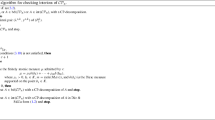Abstract
The cone of Completely Positive (CP) matrices can be used to exactly formulate a variety of NP-Hard optimization problems. A tractable relaxation for CP matrices is provided by the cone of Doubly Nonnegative (DNN) matrices; that is, matrices that are both positive semidefinite and componentwise nonnegative. A natural problem in the optimization setting is then to separate a given DNN but non-CP matrix from the cone of CP matrices. We describe two different constructions for such a separation that apply to 5 × 5 matrices that are DNN but non-CP. We also describe a generalization that applies to larger DNN but non-CP matrices having block structure. Computational results illustrate the applicability of these separation procedures to generate improved bounds on difficult problems.
Similar content being viewed by others
References
Anstreicher K.M., Burer S.: Computable representations for convex hulls of low-dimensional quadratic forms. Math. Prog. B 124, 33–43 (2010)
Burer S., Anstreicher K.M., Dür M.: The difference between 5 × 5 doubly nonnegative and completely positive matrices. Linear Algebra Appl. 431, 1539–1552 (2009)
Barioli F.: Completely positive matrices with a book-graph. Linear Algebra Appl. 277, 11–31 (1998)
Bundfuss S., Dür M.: An adaptive linear approximation algorithm for copositive programs. SIAM J. Optim. 20, 30–53 (2009)
Bomze I.M., de Klerk E.: Solving standard quadratic optimization problems via linear, semidefinite and copositive programming. J. Global Optim. 24, 163–185 (2002)
Bomze I.M., Frommlet F., Locatelli M.: Copositivity cuts for improving SDP bounds on the clique number. Math. Prog. B 124, 13–32 (2010)
Burer S., Letchford A.N.: On nonconvex quadratic programming with box constriants. SIAM J. Optim. 20, 1073–1089 (2009)
Bomze I.M., Locatelli M., Tardella F.: New and old bounds for standard quadratic programming: dominance, equivalence and incomparability. Math. Prog. 115, 31–64 (2008)
Berman A., Shaked-Monderer N.: Completely Positive Matrices. World Scientific, Singapore (2003)
Burer S.: On the copositive representation of binary and continuous nonconvex quadratic programs. Math. Prog. 120, 479–495 (2009)
Burer S.: Optimizing a polyhedral-semidefinite relaxation of completely positive programs. Math. Prog. Comp. 2, 1–19 (2010)
Berman A., Xu C.: 5 × 5 Completely positive matrices. Linear Algebra Appl. 393, 55–71 (2004)
Dong H., Anstreicher K.: On ‘5 × 5 Completely positive matrices’. Linear Algebra Appl. 433, 1001–1004 (2010)
de Klerk E., Pasechnik D.V.: Approximation of the stability number of a graph via copositive programming. SIAM J. Optim. 12, 875–892 (2002)
Dür M., Still G.: Interior points of the completely positive cone. Electron. J. Linear Algebra 17, 48–53 (2008)
Hall M. Jr: Combinatorial Theory. Blaisdell Publishing Company, Waltham (1967)
Hogben L., Johnson C.R., Reams R.: The copositive completion problem. Linear Algebra Appl. 408, 207–211 (2005)
Kogan N., Berman A.: Characterization of completely positive graphs. Discret. Math. 114, 297–304 (1993)
Peña J., Vera J., Zuluaga L.F.: Computing the stability number of a graph via linear and semidefinite programming. SIAM J. Optim. 18, 87–105 (2007)
Väliaho H.: Almost copositive matrices. Linear Algebra Appl. 116, 121–134 (1989)
Yajima Y., Fujie T.: A polyhedral approach for nonconvex quadratic programming problems with box constraints. J. Global Optim. 13, 151–170 (1998)
Author information
Authors and Affiliations
Corresponding author
Rights and permissions
About this article
Cite this article
Dong, H., Anstreicher, K. Separating doubly nonnegative and completely positive matrices. Math. Program. 137, 131–153 (2013). https://doi.org/10.1007/s10107-011-0485-8
Received:
Accepted:
Published:
Issue Date:
DOI: https://doi.org/10.1007/s10107-011-0485-8




